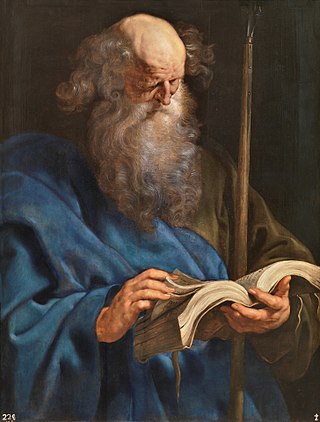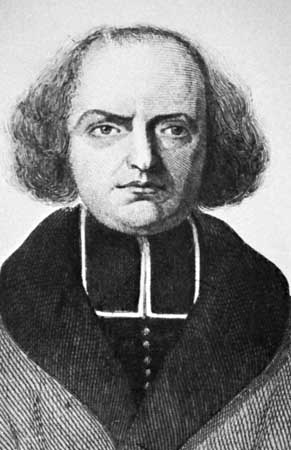Related Research Articles

Thomas the Apostle, also known as Didymus, was one of the Twelve Apostles of Jesus according to the New Testament. Thomas is commonly known as "Doubting Thomas" because he initially doubted the resurrection of Jesus Christ when he was told of it ; he later confessed his faith on seeing the places where the wounds had healed on the holy body of Jesus after the Crucifixion of Jesus. While it is often assumed he touched the wounds in art and poetry, the scriptures do not say that he touched the wounds, merely that Jesus invited him to do so, with it being unclear if he actually felt them.

John of Damascus or John Damascene was an Arab Christian monk, priest, hymnographer, and apologist. He was born and raised in Damascus c. 675 or 676; the precise date and place of his death is not known, though tradition places it at his monastery, Mar Saba, near Jerusalem on 4 December 749.

John VI Kantakouzenos or Cantacuzene was a Byzantine Greek nobleman, statesman, and general. He served as grand domestic under Andronikos III Palaiologos and regent for John V Palaiologos before reigning as Byzantine emperor in his own right from 1347 to 1354. Deposed by his former ward, he was forced to retire to a monastery under the name Joasaph Christodoulos and spent the remainder of his life as a monk and historian. At age 90 or 91 at his death, he was the longest-lived of the Roman emperors.

Jacques Paul Migne was a French priest who published inexpensive and widely distributed editions of theological works, encyclopedias, and the texts of the Church Fathers, with the goal of providing a universal library for the Catholic priesthood.

Nicephorus Gregoras was a Byzantine Greek astronomer, historian, and theologian. His 37-volume Byzantine History, a work of erudition, constitutes a primary documentary source for the 14th century.

Gennadius II was a Byzantine Greek philosopher and theologian, and Ecumenical Patriarch of Constantinople from 1454 to 1464. He was a strong advocate for the use of Aristotelian philosophy in the Orthodox Church.
Theophanes the Confessor was a member of the Byzantine aristocracy who became a monk and chronicler. He served in the court of Emperor Leo IV the Khazar before taking up the religious life. Theophanes attended the Second Council of Nicaea in 787 and resisted the iconoclasm of Leo V the Armenian, for which he was imprisoned. He died shortly after his release.
The Patrologia Graeca is an edited collection of writings by the Church Fathers and various secular writers, in the Greek language. It consists of 161 volumes produced in 1857–1866 by J.P. Migne's Imprimerie Catholique, Paris.
Hesychius of Jerusalem, also spelt Hesychios and also known as Hesychius the Priest, was a Christian priest and exegete, active during the first half of the fifth century. Nothing certain is known as to the dates of his birth and death (450s?), or, indeed concerning the events of his life. Bearing as he does the title πρεσβύτερος "priest", he is not to be confused with Bishop Hesychius of Jerusalem, a contemporary of Gregory the Great.
Hesychius of Sinai was a hieromonk of Saint Catherine's Monastery on Mount Sinai, and an ascetic author of the Byzantine period in literature.
Alexander of Lycopolis was an Egyptian philosopher of the late third and early fourth centuries AD. He was the writer of a short treatise, in twenty-six chapters, against the Manicheans. He says in the second chapter of this work that he derived his knowledge of Manes' teaching apo ton gnorimon.

George Hamartolos or Hamartolus was a monk at Constantinople under Michael III (842–867) and the author of a chronicle of some importance. Hamartolus is not his name but the epithet he gives to himself in the title of his work: "A compendious chronicle from various chroniclers and interpreters, gathered together and arranged by George, a sinner ". It is a common form among Byzantine monks. German 19th century scholar Karl Krumbacher protested against the use of this epithet as a name and proposed the form Georgios Monachos.

Theodore Abū Qurrah was a 9th-century Melkite bishop and theologian who lived in the early Islamic period.
Eutychius of Alexandria was the Melkite Patriarch of Alexandria. He is known for being one of the first Christian Egyptian writers to use the Arabic language. His writings include the chronicle Nazm al-Jawhar, also known by its Latin title Eutychii Annales.
Leontius of Byzantium was a Byzantine Christian monk and the author of an influential series of theological writings on sixth-century Christological controversies. Though the details of his life are scarce, he is considered by some a groundbreaking innovator in Christian theological reflection for having introduced Aristotelian definitions into theology.
Gregory Akindynos was a Byzantine theologian of Bulgarian origin. A native of Prilep, he moved from Pelagonia to Thessaloniki and studied under Thomas Magistros and Gregory Bryennios. He became an admirer of Nikephoros Gregoras after he was shown an astronomical treatise of that scholar by his friend Balsamon in 1332, writing him a letter in which he calls him a "sea of wisdom". From Thessaloniki, he intended to move on to Mount Athos, but for reasons unknown, he was refused.

Marcus Eremita, Mark the Ascetic or Marcus the Ascetic was a Christian theologian, saint, and ascetic writer of the fifth century AD.
Smaragdus of Saint-Mihiel OSB was a Benedictine monk of Saint-Mihiel Abbey near Verdun. He was a significant writer of homilies and commentaries.
Alexander of Cyprus or Alexander Cyprius, perhaps also known as Alexander the Monk or Alexander Monachus, was apparently a 6th-century Cypriot monk active in the cloister near the sanctuary of St. Barnabas in Salaminia or Constantina. He also had as one of his aims the authentication of the ecclesiastical independence of Cyprus.

Euthymius Zigabenus or Zigadenus or Zygadenus was a 12th-century monk and commentator on the Bible. He was a friend of the Byzantine emperor Alexius I Comnenus, for whom he wrote a lengthy work on heresies, Panoplia Dogmatica or Panoply of Doctrine. This began in the apostolic era and continued down to the Bogomils, some of whom he personally examined. The entry on the Bogomils is our main source of information about them. Nothing is known about his life.
References
- ↑ John Meyendorff (1982), The Byzantine Legacy in the Orthodox Church, p. 101.
- ↑ Hamid Dabashi (1989), Authority in Islam: From the Rise of Muhammad to the Establishment of the Umayyads, p. 14.
- ↑ Le Moine, E. Varia Sacra, 2 vols. Leyden: Daniel Gaesbeeck, 1685.
- ↑ Patrologia Graeca , vol. CVI, pp. 1381–1448.
- ↑ Patrologia Graeca, vol. CVI, pp. 1448–58.
- William Cave, "Dissertatio de scriptoribus incerta aetatis" in: Scriptorum Ecclesiasticorum Historia Literaria. 2 vols. Oxonii: e Theatro Sheldoniano 1740–43, p. 11
- Remi Ceillier, Histoire générale des auteurs sacrés et ecclésiastiques; Nouvelle édition ... revue, corrigée, complétée et terminée ... par [L. M. F. Bauzon] Paris: L. Vivès, 1858–69, vol. XII, p. 103
![]() This article incorporates text from a publication now in the public domain : Butin, Romain Francis (1907). "Bartholomew of Edessa". In Herbermann, Charles (ed.). Catholic Encyclopedia . Vol. 2. New York: Robert Appleton Company. pp. 315–316.
This article incorporates text from a publication now in the public domain : Butin, Romain Francis (1907). "Bartholomew of Edessa". In Herbermann, Charles (ed.). Catholic Encyclopedia . Vol. 2. New York: Robert Appleton Company. pp. 315–316.